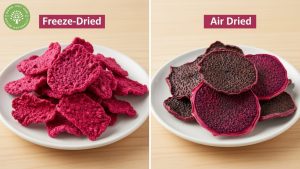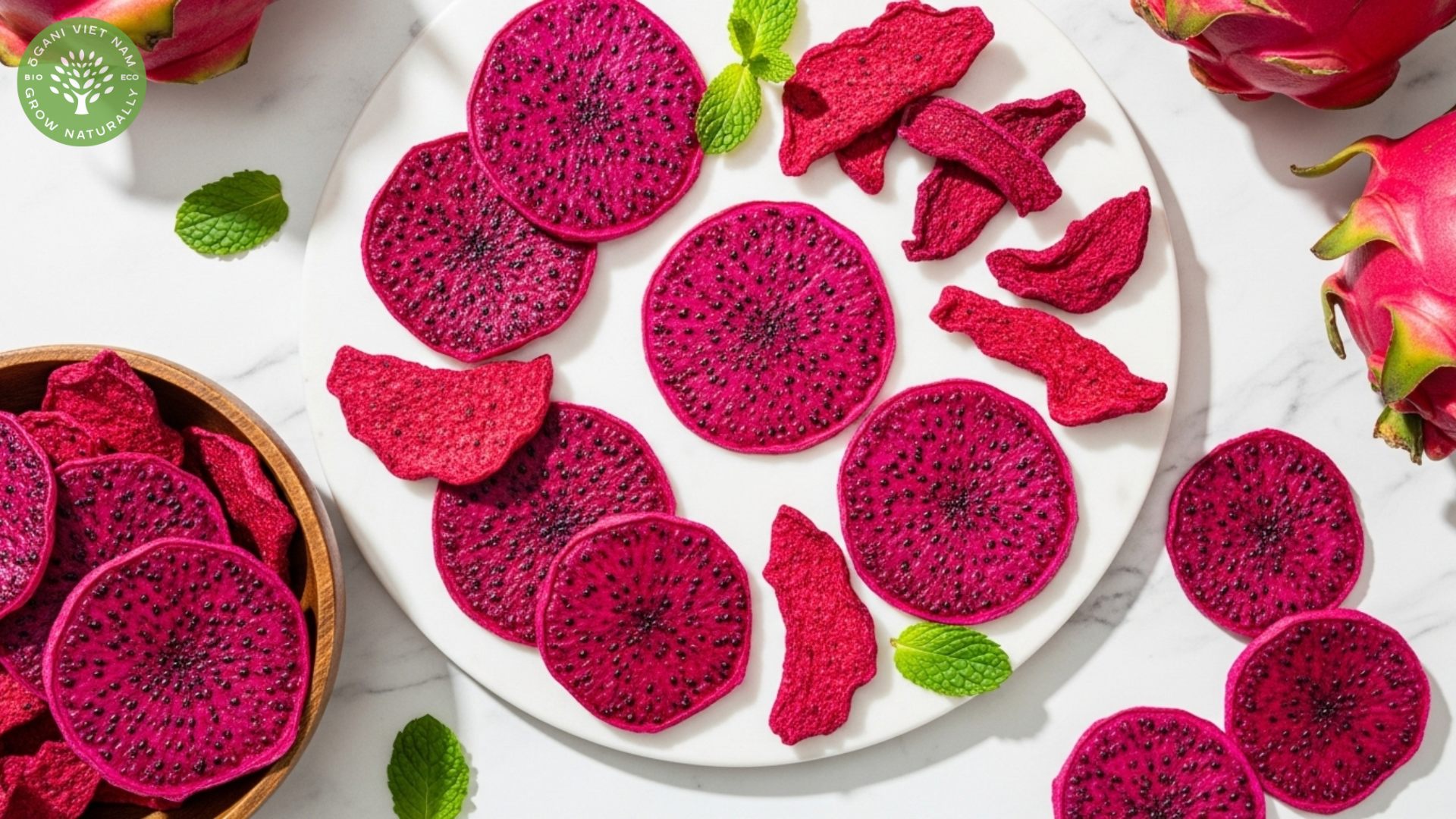If you’ve been eyeing those stunning magenta slices at the health food store, you’re onto something good. Red dragon dried fruit delivers the exotic appeal of fresh pitaya with the convenience of a grab-and-go snack – minus the sticky juice running down your wrists.
At Ogani VN, we’ve seen the curiosity around this tropical gem explode over the past year, and honestly? We get it. There’s something almost magical about a fruit that’s simultaneously so vibrant it looks unreal and so nutritious it checks every wellness box. But here’s what most people don’t realize when they first reach for a bag: not all dried dragon fruit is created equal, and understanding the difference can mean the gap between a delightful snack and a disappointing mouthful of sweetened nothing.
What makes red dragon dried fruit special?
Let’s cut through the Instagram-worthy hype for a moment. Red dragon fruit – or red pitaya, if you want to get technical – stands apart from its white-fleshed cousin in ways that actually matter once you dry it. That deep magenta color? It’s not just pretty; it signals the presence of betalains, powerful antioxidants that your body will thank you for later.
When we dry dragon fruit at Ogani VN, we’re essentially concentrating everything good about the fresh version. The natural sugars become more pronounced, yes, but you’re also getting a more potent dose of vitamins, minerals, and those antioxidants we just mentioned. Think of it like this: one ounce of dried fruit packs roughly the nutritional equivalent of several fresh slices, minus the water weight.
The flavor profile walks an interesting line. Fresh dragon fruit can be disappointingly bland if you catch it underripe (we’ve all been there), but the drying process seems to rescue and amplify its subtle sweetness. You’ll catch notes that remind you of pear, maybe a whisper of kiwi, and sometimes this delicate floral undertone that’s hard to pin down but somehow works.
Red dragon dried fruit: freeze-dried versus air-dried

This is where things get genuinely interesting, and where we see people make expensive mistakes.
Freeze-dried red pitaya: the crispy option
Freeze-dried dragon fruit is what you’ll find in those premium snack bags with the eye-watering price tags. The process flash-freezes the fruit and then removes moisture in a vacuum, leaving you with these impossibly light, crispy pieces that shatter when you bite into them. The texture is almost chip-like – satisfying in a totally different way than you’d expect from fruit.
The big advantage? Freeze-drying preserves nearly all the original nutrients and that vibrant color stays absolutely electric. We’re talking 95%+ nutrient retention, which is remarkable. The downside is cost; freeze-drying is expensive, and that expense gets passed directly to you. Expect to pay $15-30 for a small bag.
Air-dried dragon fruit: the chewy alternative
Air-dried (or dehydrated) dragon fruit takes the slower, more traditional route. Lower heat, longer time, and you end up with slices that are chewy, almost leathery, with a concentrated sweetness. Some brands add cane sugar during this process, which is something to watch for if you’re counting carbs or prefer your fruit unsweetened.
The texture here is closer to dried mango or papaya – that soft, slightly sticky chew that some people love and others find too intense. Nutrient-wise, you’ll lose a bit more compared to freeze-drying, but we’re still talking about a healthy snack option. And the price? Much more reasonable, usually $8-12 for a decent-sized package.
At Ogani VN, we offer both options because, frankly, they serve different purposes. Freeze-dried works brilliantly in yogurt bowls and smoothies where you want that crunch. Air-dried is our go-to for hiking snacks and lunchbox additions.
Nutritional benefits of red dragon dried fruit
Let’s talk about why red dragon dried fruit earned its “superfood” status without rolling our eyes too hard at the marketing term.
One serving (about 28 grams) typically delivers a solid hit of Vitamin C – we’re talking 10-15% of your daily needs, which isn’t shabby for a snack. The magnesium content supports muscle function and helps with those post-workout recovery moments. Iron levels are modest but meaningful, especially if you’re plant-based and cobbling together iron from multiple sources throughout the day.
But here’s what genuinely excites us: the antioxidant load. Those betalains we mentioned earlier? They’re the same compounds that make beets so nutritionally celebrated, and they’re showing up in research related to inflammation reduction and cellular protection. We’re not claiming dried dragon fruit will cure anything – that would be irresponsible – but as part of a varied diet, it’s pulling its weight.
The fiber content deserves a mention too. While drying concentrates sugars, it also concentrates that valuable dietary fiber that keeps your digestive system running smoothly. Just remember that because it’s concentrated, portion control matters more than with fresh fruit.
One thing we always tell customers at Ogani VN: check the ingredient list. The best red dragon dried fruit has exactly one ingredient: dragon fruit. Maybe two if you’re okay with a touch of cane sugar. Anything beyond that – artificial colors, preservatives, mysterious “natural flavors” – and you’re veering away from what makes this snack special in the first place.
Creative ways to enjoy red dragon dried fruit
This is where creativity meets practicality, and where we’ve seen customers surprise themselves.
The obvious move is eating it straight from the bag. No judgment here – sometimes simple is exactly what you need. But dried dragon fruit plays well with others in ways that might not be immediately obvious.
Toss a handful into your morning oatmeal or overnight oats. The fruit rehydrates slightly, releasing that concentrated flavor throughout your bowl. We’ve had customers swear that a few pieces transform boring plain yogurt into something they’d actually pay $12 for at a trendy breakfast spot.
Smoothie bowls are the natural Instagram habitat for this fruit, but there’s genuine substance beneath the aesthetic. The pieces add textural contrast and a flavor boost without overwhelming whatever else you’ve got going on. Plus, that magenta color bleeds beautifully into light-colored bases.
Trail mix gets infinitely more interesting with dried dragon fruit in the rotation. We like it paired with raw almonds, dark chocolate chips, and maybe some dried coconut. The fruit’s subtle sweetness balances the richness of nuts without making the whole mix taste like candy.
For the ambitious: crush freeze-dried pieces into a powder and use it as a natural food coloring for frosting, smoothies, or even homemade ice cream. It’s not just pretty; it actually contributes flavor and nutrients rather than just empty color.
And here’s something we’ve been experimenting with at Ogani VN – incorporating dried dragon fruit into savory dishes. Sounds wild, but hear us out. A few pieces rehydrated in warm water and then added to a salad dressing brings this unexpected fruity depth that works beautifully with arugula and goat cheese. Not for everyone, sure, but the adventurous eaters among you might find a new favorite.
Shopping guide: choosing quality red dragon dried fruit
Walking into a health food store or scrolling through online options can feel overwhelming when you’re staring at ten different brands of dried dragon fruit, all making similar claims. Here’s what actually matters.
Color intensity: Vibrant, deep magenta is what you want. If the pieces look faded or brownish, either the fruit wasn’t great to begin with or it’s been sitting on the shelf too long. Quality dragon fruit maintains that electric hue even after drying.
Ingredient list: We’ve said it before but it bears repeating – shorter is better. “Dragon fruit” or “Dragon fruit, cane sugar” should be the extent of it. Watch out for added sugars beyond a light dusting, artificial sweeteners, or sulfites (common preservatives in dried fruit).
Texture and flexibility: For air-dried fruit, pieces should be pliable, not rock-hard. If they’re so dry they might crack a tooth, that’s over-processed. For freeze-dried, you want that crispy-light texture, not crumbly dust at the bottom of the bag.
Certifications matter, but don’t obsess: Non-GMO, organic, vegan, gluten-free – these labels can guide you toward quality products, but dragon fruit is naturally all of these things anyway. What matters more is the drying method and whether sugar’s been added.
Packaging: Look for resealable bags with minimal air space. Dried fruit is shelf-stable, but exposure to air and light will degrade quality over time. At Ogani VN, we package in small batches specifically to ensure you’re getting the freshest product possible.
Price as a quality indicator: Not always, but often. If you’re seeing red dragon dried fruit for suspiciously cheap, question whether it’s been bulked up with added sugars or isn’t actually the red variety (white-fleshed dragon fruit is significantly cheaper and much blander). You don’t need to mortgage your house for good dried fruit, but bargain basement prices usually signal compromises somewhere.
Frequently Asked Questions
Does dried dragon fruit taste better than fresh?
Different, not necessarily better. Fresh dragon fruit is subtle, sometimes almost too mild. Dried versions concentrate those flavors, making them more pronounced. Some people actually prefer the stronger taste of dried, while fresh-fruit purists might find it too intense. It’s genuinely a personal preference thing.
How long does red dragon dried fruit last?
Stored properly in an airtight container away from direct sunlight and moisture, you’re looking at 6-12 months for best quality. Freeze-dried tends to last longer than air-dried. If it smells off or you see any signs of mold (unlikely but possible if moisture gets in), toss it.
Is the sugar content too high for a healthy diet?
One serving of unsweetened dried dragon fruit contains roughly 15-20 grams of natural sugar. That’s comparable to other dried fruits like mango or pineapple. If you’re watching sugar intake, measure your portions instead of eating directly from the bag. The fiber helps slow sugar absorption, which is a plus.
Can kids eat dried dragon fruit?
Absolutely, and most kids love it because of the color. Just watch portion sizes with younger children – the concentrated sweetness can be intense, and you want to avoid making it seem like candy. We’ve seen parents use it successfully as a healthier treat alternative.
Why does some dried dragon fruit taste bland?
Usually because it’s made from white-fleshed dragon fruit instead of the red variety, or because the original fruit was underripe. Red dragon fruit naturally has more flavor and sweetness, which translates even after drying. This is why we at Ogani VN source specifically for the red variety.
Ready to experience red dragon dried fruit?
Red dragon dried fruit hits that sweet spot between genuinely nutritious and actually enjoyable to eat – a combination that’s harder to find than you’d think in the health food world. Whether you go for the crispy elegance of freeze-dried or the chewy satisfaction of air-dried, you’re getting a concentrated dose of tropical goodness that works as hard in your morning yogurt as it does in your hiking pack.
The key is knowing what you’re buying. Read those labels, understand the processing method, and don’t be afraid to try different brands until you find your favorite. What works for one person’s taste buds might not work for yours, and that’s completely fine.
Ready to experience what the hype is actually about? Ogani VN offers both freeze-dried and air-dried red dragon fruit options, sourced from premium suppliers who share our obsession with quality. Check out our selection, and if you’re new to this, we recommend starting with a smaller bag of each type to figure out which style suits your snacking personality. Your taste buds – and your body – will appreciate the vibrant upgrade.
Read more:
-
- Organic Dried Mango: Your Complete Guide To Healthy Snacking
- How to Store Dried Mango & Maximize Shelf Life (Pantry, Fridge, Freezer)
- Dried Mango vs Freeze‑Dried Mango: Nutrition, Texture & Best Uses
- How to Rehydrate Dried Red Dragon Fruit (3 Methods) + What to Make with It
- Red Dragon Dried Fruit: Your Complete Guide to This Vibrant Superfood


